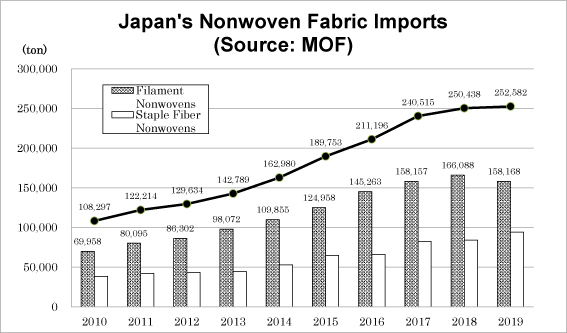Japanese imports of nonwoven fabrics in 2019 were about the same volume as the previous year.
According to Ministry of Finance customs cleared statistics, 2019 imports of filament nonwoven fabrics decreased by 4.8% compared to the previous year to 158,168 tons, while those of staple fiber nonwoven fabrics increased by 11.9% to 94,414 tons, thus surpassing the 90,000-ton level for the first time.
The import total of the two types rose 0.9% to 252,582 tons.
Imports of polypropylene filament nonwoven fabrics, which accounted for almost 85% of filament nonwovens, decreased by 7.2% to 133,214 tons. The majority of polypropylene filament nonwovens, of which the main applications are sanitary products including disposable diapers, have a weight of 25 grams per 10,000 square meters or lighter.
Imports of this weight class decreased by 8.4% to 118,576 tons. Imports from Korea (the largest supplier) declined by 2.9%, and those from China dropped 19.9%. In Korea, Toray Industries, Inc. has a base for producing polypropylene filament nonwoven fabrics, and Toray and Mitsui Chemicals, Inc. have production bases in China. Meanwhile, imports from Thailand increased by 8.3%. Mitsui Chemicals and Asahi Kasei Corporation have production bases in this Southeast Asian country.
Imports of polyester filament nonwoven fabrics sharply increased by 22.9% to 13,703 tons. Imports increased for fabrics weighing 70 grams per 10,000 square meters or heavier, which occupy the majority of imports. Especially, imports from Thailand, where Unitika Ltd. has a production base, jumped 37.3% for fabrics weighing between 70 and 150 grams and fivefold for fabrics weighing 150 grams or heavier.
Imports of staple fiber nonwoven fabrics increased for polyester, polypropylene, rayon and other types. Imports of rayon staple fiber nonwoven fabrics, which account for slightly over 40% of the total, exceeded 40,000 tons for the first time, with an increase of 14.7% to 41,127 tons.
Imports of the rayon type weighing between 25 and 70 grams occupy the mainstay. Imports of this type from China (the largest supplier) rose 5.2%, along with those from Taiwan (the second largest supplier) by 48.1%.
